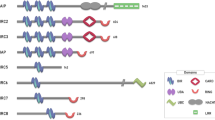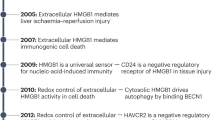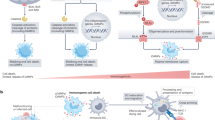Abstract
Recent studies have revealed two new functions of prothymosin α (ProTα), a well-known protein and a subject of intense research. In addition to acting as an immunomodulator and stimulating cell proliferation, ProTα is involved in protecting the cell from apoptosis and regulating the expression of oxidative stress defense genes. The review considers the methods and approaches used to demonstrate the two new functions of ProTα.
Similar content being viewed by others
REFERENCES
Haritos A.A., Goodall G.J., Horecker B.L. 1984. Prothymosin alpha: Isolation and properties of the major immunoreactive form of thymosin alpha 1 in rat thymus. Proc. Natl. Acad. Sci. USA, 81, 1008–1011.
Haritos A.A., Blacher R., Stein S., Caldarella J., Horecker B.L. 1985. Primary structure of rat thymus prothymosin alpha. Proc. Natl. Acad. Sci. USA. 82, 343–346.
Eschenfeldt W.H., Berger S.L. 1986. The human prothymosin alpha gene is polymorphic and induced upon growth stimulation: Evidence using a cloned cDNA. Proc. Natl. Acad. Sci. USA. 83, 9403–9407.
Gast K., Damaschun H., Eckert K., Schulze-Forster K., Maurer H.R., Muller-Frohne M., Zirwer D., Czarnecki J., Damaschun G. 1995. Prothymosin alpha: A biologically active protein with random coil conformation. Biochemistry. 34, 13211–13218.
Uversky V.N.,.Gillespie J.R, Millett I.S., Khodyakova A.V., Vasiliev A.M., Chernovskaya T.V., Vasilenko R.N., Kozlovskaya G.D., Dolgikh D.A., Fink A.L., Doniach S., Abramov V.M. 1999. Natively unfolded human prothymosin alpha adopts partially folded collapsed conformation at acidic pH. Biochemistry. 38, 15009–15016.
Vartapetian A.B., Uversky V.N. 2003. Prothymosin alpha: A simple yet mysterious protein. In: Protein Structures: Kaleidoscope of Structural Properties and Functions. India: Research Signpost.
Pineiro A., Cordero O.J., Nogueira M. 2000. Fifteen years of prothymosin alpha: Contradictory past and new horizons. Peptides. 21, 1433.
Eschenfeldt W.H., Manrow R.E., Krug M.S., Berger S.L. 1989. Isolation and partial sequencing of the human prothymosin alpha gene family. Evidence against export of the gene products. J. Biol. Chem. 264, 7546–7555.
Watts J.D., Cary P.D., Crane-Robinson C. 1989. Prothymosin alpha is a nuclear protein. FEBS Lett. 245, 17–20.
Manrow R.E., Sburlati A.R., Hanover J.A., Berger S.L. 1991. Nuclear targeting of prothymosin alpha. J. Biol. Chem. 266, 3916–3924.
Clinton M., Graeve L., Dorry H., Rodrigues-Boulan E., Horecker B.L. 1991. Evidence for nuclear targeting of prothymosin a and parathymosin synthesized in situ. Proc. Natl. Acad. Sci. USA. 88, 6608–6612.
Rubtsov Y.P., Zolotukhin A.S., Vorobjev I.A., Chichkova N.V., Pavlov N.A., Karger E.M., Evstafieva A.G., Felber B.K., Vartapetian A.B. 1997. Mutational analysis of human prothymosin alpha reveals a bipartite nuclear localization signal. FEBS Lett. 413, 135–141.
Sburlati A.R., Manrow R.E., Berger S.L. 1991. Prothymosin alpha antisense oligomers inhibit myeloma cell division. Proc. Natl. Acad. Sci. USA. 88, 253–257.
Rodriguez P., Vinuela J.E., Alvarez-Fernandez L., Gomez-Marquez J. 1999. Prothymosin alpha antisense oligonucleotides induce apoptosis in HL-60 cells. Cell Death Differ. 6, 3–5.
Rodriguez P., Vinuela J.E., Alvarez-Fernandez L., Buceta M., Vidal A., Dominguez F., Gomez-Marquez J. 1998. Overexpression of prothymosin a accelerates proliferation and retards differentiation in HL-60 cells. Biochem. J. 331, 753–761.
Orre R.S., Cotter M.A., Subramanian C., Robertson E.S. 2000. Prothymosin alpha functions as a cellular oncoprotein by inducing transformation of rodent fibroblasts in vitro. J. Biol. Chem. 276, 1794–1799.
Pavlov N., Evstafieva A., Rubtsov Y., Vartapetian A. 1995. Human prothymosin alpha inhibits division in yeast Saccharomyces cerevisiae cells, while its mutant lacking nuclear localization signal does not. FEBS Lett. 366, 43–46.
Evstafieva A.G., Belov G.A., Kalkum M., Chichkova N.V., Bogdanov A.A., Agol V.I., Vartapetian A.B. 2000. Prothymosin alpha fragmentation in apoptosis. FEBS Lett. 467, 150–154.
Evstafieva A.G., Belov G.A., Rubtsov Y.P., Kalkum M., Joseph B., Chichkova N.V., Sukhacheva E.A., Bogdanov A.A., Pettersson R.F., Agol V.I., Vartapetian A.B. 2003. Apoptosis-related fragmentation, translocation, and properties of human prothymosin alpha. Exp. Cell Res. 284, 211–223.
Evstafieva A.G., Chichkova N.V., Makarova T.N., Vartapetian A.B., Vasilenko A.V., Abramov V.M., Bogdanov A.A. 1995. Overproduction in Escherichia coli, purification and properties of human prothymosin alpha. Eur. J. Biochem. 231, 639–643.
Sukhacheva E.A., Evstafieva A.G., Fateeva T.V., Shakulov V.R., Efimova N.A., Karapetian R.N., Rubtsov Y.P., Vartapetian A.B. 2002. Sensing prothymosin alpha origin, mutations and conformation with monoclonal antibodies. J. Immunol. Meth. 266, 185–196.
Freire M., Rey-Mendez M., Gomez-Marquez J., Arias P. 1985. Evidence for the synthesis of thymosin alpha 1 by calf thymocytes and the production of this peptide by natural processing. Arch. Biochem. Biophys. 239, 480–485.
Naylor P.N., Friedman-Kien A., Hersh E., Erdos M., Goldstein A.L. 1986. Thymosin alpha 1 and thymosin beta 4 in serum: Comparison of normal, cord, homosexual and AIDS serum. Int. J. Immunopharmacol. 8, 667–676.
Jiang X., Kim H.E., Shu H., Zhao Y., Zhang H., Kofron J., Donnelly J., Burns D., Ng S.C., Rosenberg S., Wang X. 2003. Distinctive roles of PHAP proteins and prothymosin-alpha in a death regulatory pathway. Science. 299, 223–226.
Acehan D., Jiang X., Morgan D.G., Heuser J.E., Wang X., Akey C.W. 2002. Three-dimentional structure of the apoptosome: Implications for assembly, procaspase-9 binding and activation. Mol. Cell. 9, 423–432.
Adrain C., Martin S.J. 2001. The mitochondrial apoptosome: A killer unleashed by the cytochrome seas. Trends Biochem. Sci. 26, 390–397.
Markova O.V., Evstafieva A.G., Mansurova S.E., Moussine S.S., Palamarchuk L.A., Pereverzev M.O., Vartapetian A.B., Skulachev V.P. 2003. Cytochrome c is transformed from anti-to pro-oxidant when interacting with truncated oncoprotein prothymosin alpha. Biochim. Biophys. Acta. 1557, 109–117.
Papamarcaki T., Tsolas O. 1994. Prothymosin alpha binds to histone H1 in vitro. FEBS Lett. 345, 71–75.
Martini P.G., Delage-Mourroux R., Kraichely D.M., Katzenellenbogen B.S. 2000. Prothymosin alpha selectively enhances estrogen receptor transcriptional activity by interacting with a repressor of estrogen receptor activity. Mol. Cell Biol. 17, 6224–6232.
Karetsou Z., Kretsovali A., Murphy C., Tsolas O., Papamarcaki T. 2002. Prothymosin alpha interacts with the CREB-binding protein and potentiates transcription. EMBO Rep. 3, 361–366.
Cotter M.A., Robertson E.S. 2000. Modulation of histone acetyltransferase activity through interaction of Epstein-Barr nuclear antigen 3C with prothymosin alpha. Mol. Cell Biol. 20, 5722–5735.
Subramanian C., Hasan S., Rowe M., Hottiger M., Orre R., Robertson E.S. 2002. Epstein-Barr virus nuclear antigen 3C and prothymosin alpha interact with the p300 transcriptional coactivator at the CH1 and CH3/HAT domains and cooperate in regulation of transcription and histone acetylation. J. Virol. 76, 4699–4708.
Yang C.H., Murti A., Baker S.J., Frangou-Lazaridis M., Vartapetian A.B., Murti K.G., Pfeffer L.M. 2004. Interferon induces the interaction of prothymosin-alpha with STAT3 and results in the nuclear translocation of the complex. Exp. Cell Res. 298, 197–206.
Kubota S., Adachi Y., Copeland T.D., Oroszlan S. 1995. Binding of human prothymosin alpha to the leucine-motif/activation domains of HTLV-I Rex and HIV-1 Rev. Eur. J. Biochem. 233, 48–54.
Karetsou Z., Martic G., Tavoulari S., Christoforidis S., Wilm M., Gruss C., Papamarcaki T. 2004. Prothymosin alpha associates with the oncoprotein SET and is involved in chromatin decondensation. FEBS Lett. 577, 496–500.
Fields S., Song O. 1989. A novel genetic system to detect protein-protein interactions. Nature. 340, 245–247.
Karapetian R.N., Evstafieva A.G., Abaeva I.S., Chichkova N.V., Filonov G.S., Rubtsov Y.P., Sukhacheva E.A., Melnikov S.V., Schneider U., Wanker E.E., Vartapetian A.B. 2005. Nuclear oncoprotein prothymosin alpha is a partner of Keap1: Implications for expression of oxidative stress-protecting genes. Mol. Cell Biol. 25, 1089–1099.
Itoh K., Wakabayashi N., Katoh Y., Ishii T., Igarashi K., Engel J.D., Yamamoto M. 1999. Keap1 represses nuclear activation of antioxidant responsive elements by Nrf2 through binding to the amino-terminal Neh2 domain. Genes Develop. 13, 76–86.
Chichkova N.V., Evstafieva A.G., Lyakhov I.G., Tsvetkov A.S., Smirnova T.A., Karapetian R.N., Karger E.M., Vartapetian A.B. 2000. Divalent metal cation binding properties of human prothymosin alpha. Eur. J. Biochem. 267, 4745–4752.
Hayes J.D., McMahon M. 2001. Molecular basis for the contribution of the antioxidant response element to cancer chemoprevention. Cancer Lett. 174, 103–113.
Rushmore T.N., Morton M.R., Pickett C.B. 1991. The antioxidant responsive element. Activation by oxidative stress and identification of the DNA consensus sequence required for functional activity. J. Biol. Chem. 266, 11632–11639.
Xue F., Cooley L. 1993. Kelch encodes a component of intercellular bridges in Drosophila egg chambers. Cell. 72, 681–693.
Kang M.L., Kobayashi A., Wakabayashi N., Kim S.G., Yamamoto M. 2004. Scaffolding of Keap1 to the actin cytoskeleton controls the function of Nrf2 as key regulator of cytoprotective phase 2 genes. Proc. Natl. Acad. Sci. USA. 101, 2046–2051.
McMahon M., Itoh K., Yamamoto M., Hayes J.D. 2003. Keap1-dependent proteasomal degradation of transcription factor Nrf2 contributes to the negative regulation of antioxidant response element-driven gene expression. J. Biol. Chem. 278, 21592–21600.
Zhang D.D., Hannink M. 2003. Distinct cysteine residues in Keap1 are required for Keap1-dependent ubiquitination of Nrf2 and for stabilization of Nrf2 by chemopreventive agents and oxidative stress. Mol. Cell. Biol. 23, 8137–8151.
Kobayashi M., Yamamoto M. 2005. Molecular mechanisms activating the Nrf2-Keap1 pathway of antioxidant gene regulation. Antioxid. Redox Signal. 7, 385–394
Huang H.C., Nguyen T., Pickett C.B. 2002. Phosphorylation of Nrf2 at Ser-40 by protein kinase C regulates antioxidant response element-mediated transcription. J. Biol. Chem. 277, 42769–42774.
Cullinan S.B., Zhang D.D., Hannink M., Arvisais E., Kaufman R.J., Diehl J.L. 2003. Nrf2 is a direct PERK substrate and effector of PERK-dependent cell survival. Mol. Cell. Biol. 23, 7198–7209.
Bloom D.A., Jaiswal A.K. 2003. Phosphorylation of Nrf2 at Ser-40 by protein kinase C in response to antioxidants leads to the release of Nrf2 from INrf2, but is not required for Nrf2 stabilization/accumulation in the nucleus and transcriptional activation of antioxidant response element-mediated NAD(P)H:quinone oxyreductase-1 gene expression. J. Biol. Chem. 278, 44675–44682.
Levonen A.L., Landar A., Ramachandran A., Ceaser E.K., Dickinson D.A., Zanoni G., Morrow J.D., Darley-Usmar V.M. 2004. Cellular mechanisms of redox cell signaling: The role of cysteine modification in controlling antioxidant defences in response to electrophilic lipid oxidation products. Biochem. J. 378, 373–382.
Wakabayashi N., Dinkova-Kostova A.T., Holtzclaw W.D., Kang M.I., Kobayashi A, Yamamoto M., Kensler T.W., Talalay P. 2004. Protection against electrophilic and oxidant stress by induction of of the phase 2 response: fate of cysteins of the Keap1 sensor modified by inducers. Proc. Natl. Acad. Sci. USA. 101, 2040–2045.
Alam J., Stewart D., Touchard C., Boinapally S., Choi A.M., Cook J.L. 1999. Nrf2, a Cap'n' Collar transcription factor, regulates induction of the heme oxygenase-1 gene. J. Biol. Chem. 274, 26071–26078.
Ishii T., Itoh K., Takahashi S., Sato H., Yanagawa T., Katoh Y., Bannai S., Yamamoto M. 2000. Transcription factor Nrf2 coordinataly regulates a group of oxidative stress-inducible genes in macrophages. J. Biol. Chem. 275, 16023–16029.
Caplen N.J., Parrish S., Imani F., Fire A., Morgan R.A. 2001. Specific inhibition of gene expression by small double-stranded RNAs in invertebrate and vertebrate systems. Proc. Natl. Acad. Sci. USA. 98, 9742–9747.
Elbashir S.M., Harborth J., Lendeckel W., Yalcin A., Weber K., Tuschl T. 2001. Duplexes of 21-nucleotide RNAs mediate RNA interference in cultured mammalian cells. Nature. 411, 494–498.
Author information
Authors and Affiliations
Additional information
__________
Translated from Molekulyarnaya Biologiya, Vol. 39, No. 5, 2005, pp. 729–745.
Original Russian Text Copyright © 2005 by Evstafieva, Karapetian, Rubtsov, Filonov, Abaeva, Fateeva, Melnikov, Chichkova, Vartapetian.
Rights and permissions
About this article
Cite this article
Evstafieva, A.G., Karapetian, R.N., Rubtsov, Y.P. et al. New Functions of a Well-Known Protein: Prothymosin α Is Involved in Protecting Cells from Apoptosis and Oxidative Stress. Mol Biol 39, 631–645 (2005). https://doi.org/10.1007/s11008-005-0079-8
Received:
Issue Date:
DOI: https://doi.org/10.1007/s11008-005-0079-8




